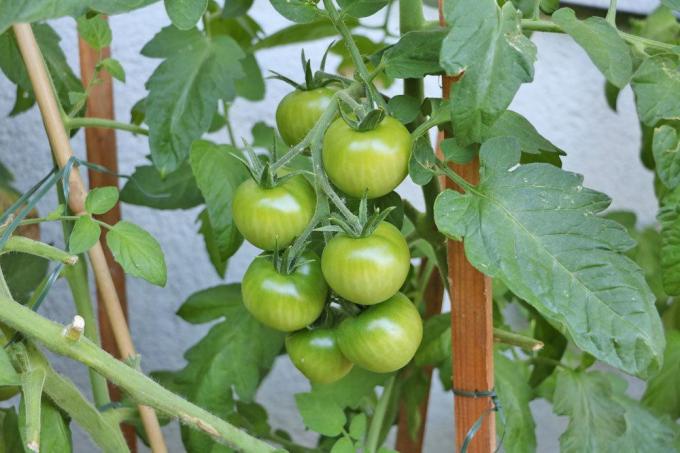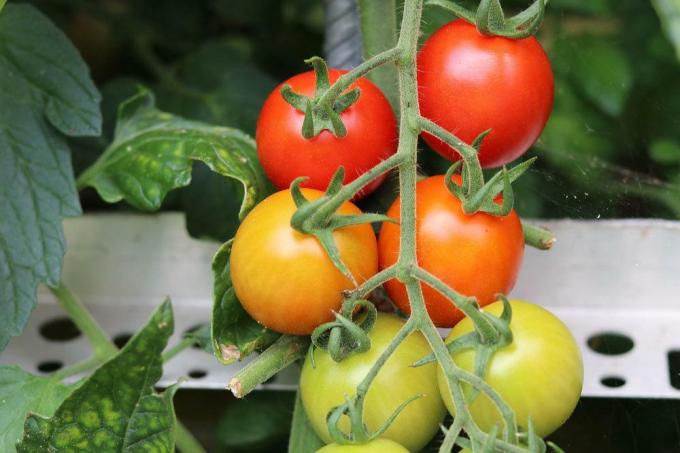
table of contents
- Let the tomatoes ripen
- Harvest time
- Optimal conditions for post-ripening
- Methods and approach
- In clay pots
- In boxes or boxes
- Using a cold frame or a cold box
- Let the plant ripen
- Green, unripe fruits are poisonous
The more beautiful the summer, the earlier tomatoes can be harvested. If the conditions are not ideal, tomato plants can still bear a lot of green, unripe fruit in late summer and autumn. Due to the cooler temperatures, these fruits no longer turn red. If you don't help out now and help the fruit ripen, part of the tomato harvest will be lost. Ripening can be done in different ways without great effort.
Let the tomatoes ripen
Harvest time
Don't wait too long to harvest
You shouldn't wait too long to harvest unripe fruits, because even the smallest ones Minus degrees would let it spoil. If the temperatures drop below 10 degrees, the fruits will no longer turn red or yellow outside, depending on the variety. The cold night dew can already damage the tomato skin in the form of glassy areas and cause it to rot.
As a result, it is advisable to harvest before temperatures drop permanently below 10 degrees. Depending on the space available, you can harvest the individual fruits, cut off entire panicles or pull the entire plants including fruits out of the ground and let the tomatoes ripen on the plant.
If you harvest individual fruits, you should not tear them off the bush, but cut them off together with the stem. The fruits can be damaged by tearing, which in turn encourages the penetration of germs. The stem should generally stay on the fruit. It ensures the intense aroma during the ripening process.
tip: Fruits that have bruises, cracks or other damage are no longer suitable for subsequent ripening. Only intact fruits should be used for this.
Optimal conditions for post-ripening
- Tomatoes need warmth and high humidity to ripen
- Temperatures for tires between 16 ° C and 25 ° C
- 18-20 ° C are ideal
- The cooler it is, the longer it takes to mature
- The ripening process can then drag on until December / January
- If there is enough warmth and humidity, it can take up to three weeks
- Relative humidity of more than 80 percent is ideal
There is no need for light at all. As long as tomatoes are growing and fruit and seeds are developing, they also need sufficient light. As soon as they are fully grown, they can cope with significantly less light, because light is not absolutely necessary for the typical red color.
Methods and approach
In clay pots
In clay vessels such as B. A Roman pot or an oriental clay pot (tagine) should ripen the tomato particularly quickly and gently. Before the pot can be filled, it must be cleaned well. Then you put it in the water for a few hours.
Then you layer the dry fruits in the clay vessel and cover it with a lid made of clay at best. The coaster is filled with water, and as soon as the water has evaporated, you refill it again. The whole thing is then placed in a suitably warm and humid place. It won't be long now and the first tomatoes are red and taste like they have ripened in the sun.
In boxes or boxes
With larger quantities of fruit, you can also use boxes, cardboard boxes or baskets in which the unripe tomatoes are layered for subsequent ripening.
- First line boxes or cartons with newspaper
- Then lay out the loose fruits or tomato panicles side by side
- Use only healthy and undamaged fruit
- For larger quantities, place the fruits in two layers on top of each other
- Cover the first layer with several layers of newspaper beforehand
- Then put the second layer of fruit on top
- It shouldn't be more than two layers
- Finally, cover the second layer with paper as well
- Place the boxes in a warm, dark and humid place
From now on, the tomatoes should be checked daily for rot or mold and any sick or damaged ones should be sorted out. If you want to speed up the ripening process a bit, you can put an apple, pear or banana with the tomatoes in the box. The ethylene contained in this fruit makes unripe tomatoes ripen faster.

tip: Fruits whose ripening process has been accelerated with ethylene often spoil faster, although they also produce the gas themselves. For this reason, foods that are sensitive to ethylene should not be stored or stored near apples. store.
Using a cold frame or a cold box
If the weather conditions allow it and the outside temperature does not drop below 12 ° C, unripe tomatoes can also be left to ripen in a cold frame or a cold box. First you need a solid base such as B. a wooden board. This is to prevent the fruits from coming into contact with the ground and from rotting.
Place the board next to or in front of the plant and bend it so that the tomatoes lie on the board. Now you put a cold frame or cold box over the fruit and cover the whole thing with an insulating and opaque fleece or a warming film. In this way, these fruits can also ripen in a greenhouse.
Let the plant ripen
Green, unripe fruits can also ripen very well on the plant, provided there is enough space available. To do this, pull the entire plant, including its roots, out of the ground or cut it off close to the ground. Then you remove the leaves, otherwise the tomatoes can become wrinkled. Now hang the plants upside down in a warm, humid place. This can be a dark attic, basement or a similarly dark room with high humidity. Here, too, it is important to ensure that all fruits are undamaged.
Green, unripe fruits are poisonous
Unripe, green tomatoes are left to ripen in order to reduce undesirable active substances in the fruits and to bring them to full ripeness. What one should never do is eat unripe green fruits because they are poisonous. This is due to the substance solanine, which is also known from green potatoes.
- Solanine is found in high concentrations in unripe fruits
- Solanine in this concentration is hazardous to health
- Contains between 9 and 32 milligrams of solanine per 100 g of fruit
- From a dose of 25 milligrams, this active ingredient is considered toxic
- This natural poison is fatal from a dose of 400 milligrams
- Solanine is fat-insoluble and heat-resistant
- Toxicity is therefore retained even when cooked
The first symptoms of poisoning can occur with an intake of 200 milligrams or more. It can cause itching in the throat, nausea and vomiting, as well as gastrointestinal problems, headaches, drowsiness, tenderness and breathing problems. At even higher doses, body aches, kidney and bowel inflammation as well as cardiac arrhythmias and symptoms of paralysis are possible. In the course of the ripening process, the concentration of the poison in the fruit decreases. They still contain solanine, but in such a low concentration that it is no longer hazardous to health.

tip: One should not confuse unripe green tomatoes with green-fleshed varieties that are slightly yellow-green when fully ripe. When immature, they also contain large amounts of solanine and are poisonous.
Note: Please note that this article does not in any way replace a visit to the doctor. There is no guarantee that medical statements are correct.
You will find detailed information on first aid in the event of poisoning and important information on poison control centers here.

